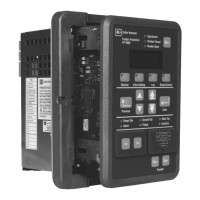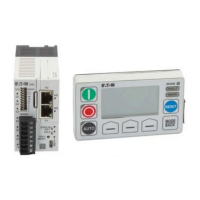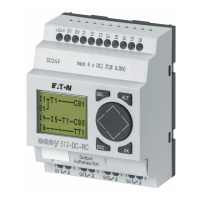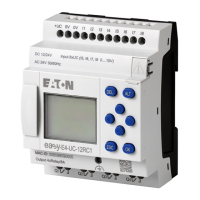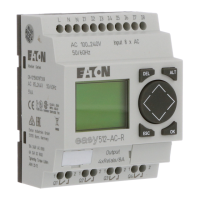I.L. 17562
Page 97
PR 0.3 Effective 8/99
current is zero. As long as the MP-3000 is not in a trip state, it will permit contactor energization
by closing its trip contact in series with the contactor. The contactor is energized by the operator
or process control system through a normal two-wire or three-wire motor control scheme,
external to the MP-3000. The MP-3000 declares a motor start when it sees motor current
exceeding 30 percent of the FLA setpoint (P1L1). The message START is displayed and the
transition timer (TRNT, P5L6) begins to run. Also, the MP-3000 watches the large starting
current, noting when the current falls below the transition level TRNC, P5L5.
Using the TRN XXX setpoint P5L7, the user can select one of four transition behaviors:
TRN TIME — Transition to RUN after time setting (P5L6) only. Ignore current.
TRN I — Transition when starting current drops below setting (P5L5) only. If the time set in
TRNT P5L6 expires before the current transition, trip the motor.
TRN T+C — Transition on time or current, whichever comes first.
TRN T/C — Transition on time and current. Both must occur, and the current must drop below
the setting before the time delay expires. If the timer expires before the current falls below the
set transition level, trip the motor.
If there is no transition trip, and the relay declares a successful transition, the display and data
communications messages say RUN. If P10L1 is set to TRN ON, the AUX 2 output relay will
operate its contact when the transition is declared. This contact controls a reduced-voltage
starter, switching to full running voltage.
Even if the transition control output contact is not used, set the transition function to provide
clear indications of the actual state of the motor (START versus RUN) on the front-panel display
and via data communications. A good way to do this is to use the factory default settings of
P5L7 = TRN I and P5L5 = 130% of FLA. Modify the latter, if needed, to lie at a transition value
between the starting current and post-start maximum load current. Set transition timer well
beyond normal start time to avoid a transition trip.
9.2.2 Start Delays - When the MP-3000 declares a START, all start timers of enabled functions
begin to time. Each of these timers blocks the respective function until the set delay expires.
These start timers don’t care about transition – they run for the set time, which may be less than
or greater than the time of transition. These timers include:
• Ground fault start delay (GFSD, P3L2)
• Instantaneous overcurrent start delay (IOCSD, P3L5)
• Jam trip and alarm start delay (JMSD, P3L7)
• Underload trip and alarm start delay (ULSD, P3L10)
• Unbalance trip and alarm start delay (UBSD, P3L13)
Also, at the time of the start, the counters and timers for the jogging controls are updated. These
include starts allowed per time (ST/T and T/ST, P5L1 and P5L2), time between starts (TBS,
P5L3), and number of cold starts allowed (NOCS, P5L4). If a jogging limit is reached, only a
STEX alarm occurs, but if the limit still applies when the motor next stops then the motor is
tripped and blocked at that time.
9.2.3 Run Cycle — Once the transition occurs, the MP-3000 declares the run state for the
motor; a RUN message is displayed and communicated to the PowerNet host.
9.2.4 Run Delays – Note that run delays on trip and alarm functions don’t have any particular
relationship to the transition to the RUN state of the relay. Run delays are pickup delays on
active functions, which are able to measure as soon as the respective start delay has expired –
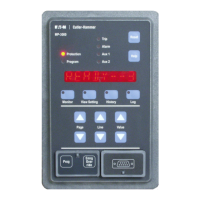
